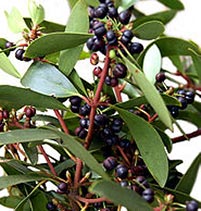What is Pepperberry?
Common names for pepperberry include: mountain pepperleaf, mountain pepper , mountain pepperberry, Dorrigo pepper The Tasmannia genus of peppers, native to Australia, including pepperberry (also known as mountain pepper) and DLorrigo pepper, should not be confused with native pepper which is a vine and member of the Piperaceae family.
Mountain pepper and Dorrigo pepper plants are similar to each other, except that the Dorrigo variety is from a more northern habitat along the eastern seaboard of New South Wales, Australia and it has a less pungent taste. Hence the botanical name T insipida . Dorrigo pepper grows wild in New South Wales, Queensland and the Northern Territory. Although these plants grow prolifically on the East Coast of Australia, there appears to be no evidence of their culinary or medicinal application by the indigenous people. It is thought that some nineteenth century colonists made use of its bark, possibly as an external liniment, however culinary interest in the flavor components of Australian native plants is a recent twentieth century development.
Description
Pepperberry shrubs are distinguished by the attractive deep red of their young stems and branches, which color in the same way as new, crimson gum tips. In ideal conditions, pepperberry will grow from 13-16 ft. (4-5 m) tall. The broad-based, tapering leaves on mountain pepper are longer on plants growing in lowland areas, up to 5 in. (13 cm), and much shorter on alpine dwelling ones that may have leaves only 1/2 in. (1.5 cm) in length.
Small yellow to cream colored flowers are followed by shiny, deep-purple to black, plump fruits about 1/4 in. (5 mm) in diameter and containing a cluster of tiny black seeds inside. The leaves, fruits and even the fresh flower buds all have a distinct pepperberry aroma and taste, albeit at varying intensities.
The berries are dark bluey-black in colour and have a 5 – 8mm diameter knobbly round shape, with a ridge around the centre. Pepperberry is stronger when dried, has a pleasing woody fragrance with vague pepper and dry, cinnamon -like notes. The flavor is similarly woody and camphor-like until its sharp pepper taste and lingering heat becomes apparent. Pepperberry has an oily, mineral-like, turpentine aroma.
Warning: when even minute grains of the ground fruits are tasted, an initial sweet, fruity flavor is quickly followed by an intense, biting, tongue-numbing and eye-watering heat that continues to build and will not subside for several minutes. This continuing heat development which is experienced with both the leaves and the berries is a result of the enzymes contained in mountain pepper being activated by one’s saliva.
Purchasing and Storage
Pepperberry is predominantly sold in its powdered form, which will look somewhat granular, and have a khaki color. Buy small quantities, as only a tiny amount is sufficient to flavor food and once ground, flavor loss is more rapid even under ideal storage conditions. Pepperberry is occasionally available in their frozen form but it is more common to find them ground to a coarse, oily-looking black powder. Store both the powdered leaves and berries in airtight packs and keep well protected from extremes of heat, light and humidity.
Cooking with Pepperberry
Pepperberry, when dried and powdered, may be used in the same way as ground black or white pepper (P nigrum). Because the flavor is relatively sharp and intense, I would recommend adding less than half the amount of mountain pepperleaf and then increasing the quantity to suit your own taste. With pepperberry however, extreme caution is suggested and my rule of thumb is to use only one tenth of the quantity when compared to conventional pepper.
Pepperberry goes well with other Australian native herbs and spices such as lemon myrtle , wattleseed and bush tomato. A lemon pepper mix may be made by blending, in whatever proportions suit your taste, lemon myrtle leaf powder with mountain pepperleaf and salt. Blend mountain pepperleaf with ground coriander seed, wattleseed, akudjura and salt to sprinkle on kangaroo fillets before cooking.
Do not use ground pepperberries directly onto food — they’re just too bitingly hot. Mountain pepperberries are delicious when put into slow-cooked dishes like stews and soups, as the extended cooking time tends to dissipate their pungency and the unusual flavor gets a chance to really complement the food. They are also excellent with game meats and when used sparingly, in marinades for both white and red meat..
Names in Other Languages
French: Poivre indigène German: tasmanischer pfeffer, bergpfeffer, Australischer pfeffer Italian (mountain pepper leaf): pepe di montagna Australiano macmate Italian (mountain pepper berry): bacche di pepe montagna Australiano macmate
Scientific Names
Mountain pepper/Tasmanian pepper: Tasmannia Ianceolata Dorrigo pepper: Tasmannia insipida Family: Winteraceae
Recipes using Pepperberry
- Pepperberry And Strawberry Dressing
- Fillet of Beef with Pepperberry
- Lamb Cutlets With Australian Spices
- Pepper Beef Stew
- Pepperberry Casserole
You may also be interested in Wattelseed , Lemon Myrtle and Bush Tomato
CSIRO / CC BY (https://creativecommons.org/licenses/by/3.0)commons.wikimedia.org/wiki/File:CSIRO_ScienceImage_3982_Leaves_and_Berries_of_the_Mountain_Pepper_Tasmannia_lanceolata.jpg



